The beauty of California never ceases to amaze me. From Yosemite, Lake Tahoe, Big Sur, Death Valley to cities like Los Angeles, San Francisco, San Diego, and from the IT hub of Silicon Valley to Hollywood, California has it all. The Eastern Sierra mountain range which is the backbone of California in my opinion is one of the most beautiful destinations and the fact that it is not so popular adds to its allure.
We wanted to get away for a short 3-day trip and were looking for a place that we had not been to. I was lucky to have stumbled onto this blog by Road trip USA which was a real eye-opener for me. They not only cover all the hidden beauties of the Eastern Sierra, but they also provide a detailed itinerary and recommended stops. I highly recommend following and hitting all the spots mentioned in this blog, provided you are visiting during the right season. We planned our trip during the end of winter so we had to tweak this itinerary to suit our needs and account for road closures. We booked a 3-night stay in Bishop as it was a big enough town with plenty of hotels/motels and was easy to drive from here to each of the places of interest.
We started our drive from Los Angeles and our first stop was Red Rock Canyon State Park located around 120 miles away in Kern County. The dramatic rock formations and the layers of colorful rocks and the spectacular scenic beauty make you forget the desert sun. The park was sparsely populated with the park ranger about to close shop and head home for the day although it was just mid-afternoon. There are several hiking trails and the campgrounds are open 24 hours. We found a few campers with their trailers setting up camp all along the base of these vivid colors of rocky cliffs. Although we did not go hiking, we just spent around an hour visiting and taking pictures.



We drove another 150 miles north, enjoying the breathtaking views of the Sierra Mountains all along. After a brief stop in Lone Pine for a late lunch, we reached Bishop around 6 pm and checked into our hotel.
The next day we headed off towards Mammoth Lakes. We had quite a few places on our list and we considered extending it to the next day also if needed. But we were here in early spring and the whole of the Mammoth Lake area was covered in snow.
All the lakes were frozen over and roads closed. So unfortunately we were unable to visit all of these places: Crowley Lake Columns, Mammoth Twin Lakes, June Lake, Hot Creek Geological Park, Devil’s Postpile Monument, Bodie State Historical Park, and on the next day, the Ancient Bristlecone Pine Forest. I was really disappointed about this, but the day turned out to be pretty spectacular nonetheless, thanks to the amazing Mono Lake.

As we were unaware of the road closures, we still tried to visit Crowley, Twin, and June Lakes. The frozen lakes covered in powdery white snow along with the surrounding views were spectacular. The only activity that was open for business was skiing which is very popular during winter and spring. The beautiful ski slopes were ideal for the sport and the whole town of Mammoth Lake caters to it during this season.

June Lake

Crowley Lake

Convict Lake
We went to a visitor center that was open and was told that Mono Lake is the only location that is not frozen over as it contains saltwater. This was music to our ears as it was the highlight of our trip. I had seen some amazing Instagram pictures of this place and was really looking forward to seeing and capturing some great shots, especially of the sunset. But since we weren’t able to cover the other places on my list, we got here just after lunch and didn’t want to wait around until sunset.
 We went to the South Tufa reserve area of Mono Lake. Mono Lake is a large saline soda lake that was formed around 760,000 years ago. The most iconic feature of Mono Lake is the columns of limestone towers that cover part of the surface. These limestone towers called ‘Tufa’ are formed of a high concentration of calcium carbonate. Originally formed at the bottom of the lake over several centuries, as the water levels fell, these towers rose to be the beautiful pillars seen today. The water level has been receding quite quickly though as many of these tufa towers were visible on land.
We went to the South Tufa reserve area of Mono Lake. Mono Lake is a large saline soda lake that was formed around 760,000 years ago. The most iconic feature of Mono Lake is the columns of limestone towers that cover part of the surface. These limestone towers called ‘Tufa’ are formed of a high concentration of calcium carbonate. Originally formed at the bottom of the lake over several centuries, as the water levels fell, these towers rose to be the beautiful pillars seen today. The water level has been receding quite quickly though as many of these tufa towers were visible on land.
On approaching the lake, the tufa towers rising from the surface of the still blue-green waters creates a perfect mirror image of the tufa and is an absolutely heavenly sight.


Words fail to express the beauty surrounding this place, from the snow-covered Sierra Mountains to the serene Mono Lake with these majestic towers. This is truly heaven on earth and I was in total awe of mother nature. I couldn’t believe that we lived so close for so many years not knowing about this Californian hidden gem. 



After spending some time here taking some pictures and kicking ourselves for not coming here much earlier, we returned to our hotel in Bishop.
The next day we tried to make it up Highway 168 to visit the Ancient Bristlecone Pine Forest but after making our way up almost 15 miles, the road leading up to the Bristlecone Forest was closed. So we returned to Bishop but enjoyed the scenic drive nonetheless. We later visited the Buttermilk Boulders in Bishop.
The next morning we headed back home and on the way planned to visit the Manzanar Historical Site and the Alabama Hills. Manzanar is the site of one of ten American concentration camps where over 110,000 Japanese Americans were incarcerated during World War II from 1942 to 1945. Located at the foot of the Sierra Nevada between the towns of Lone Pine to the south and Independence to the north, Manzanar has been preserved as a historical site since World War II ended. Entrance to the visitor center is free and it houses several photographs and documentation of the legacy of Japanese Americans incarcerated during those troubled times. You can also watch the 22-minute film “Remembering Manzanar” and learn its history. 

We stopped for lunch in the city of Lone Pine and then drove up to the Whitney Portal to get a view of Mt. Whitney, which is the tallest mountain in the United States. The road beyond Whitney Portal was closed but only accessible to hikers. Although we could see the top of Mt. Whitney from the highway, we wanted to see if we could get a better view from here. But as we got closer, Mt. Whitney was overshadowed by the other mountains closer to us. But the view of the snow-covered Sierra Mountains and the drive was truly breathtaking.


On the same road back to the highway was the turnoff to Alabama Hills. These are a range of hills and rock formations and a popular filming location for tv and movies. The rounded contours of these rocks stand in stark contrast to the jagged edges of the Sierra Nevada range in the background. There are several natural arches in these rocks which are the main attraction. They can be reached with a short hike from the Whitney Portal road along with the movie flat road. Some of the notable arches are the Mobius arch, Lathe arch, the eye of Alabama, and the Whitney Portal arch. We walked on the little marked path and were able to spot the Mobius arch and the heart arch. But due to lack of cell service, I couldn’t pinpoint the location of the other 2 arches. Nevertheless, I thought that the Mobius arch, the most famous of them, is really worth the visit. We were able to climb onto the arch and take some good shots, and I was lucky enough to snap a good picture of Mt. Whitney seen through the arch.

Mt. Whitney seen through the Mobius Arch
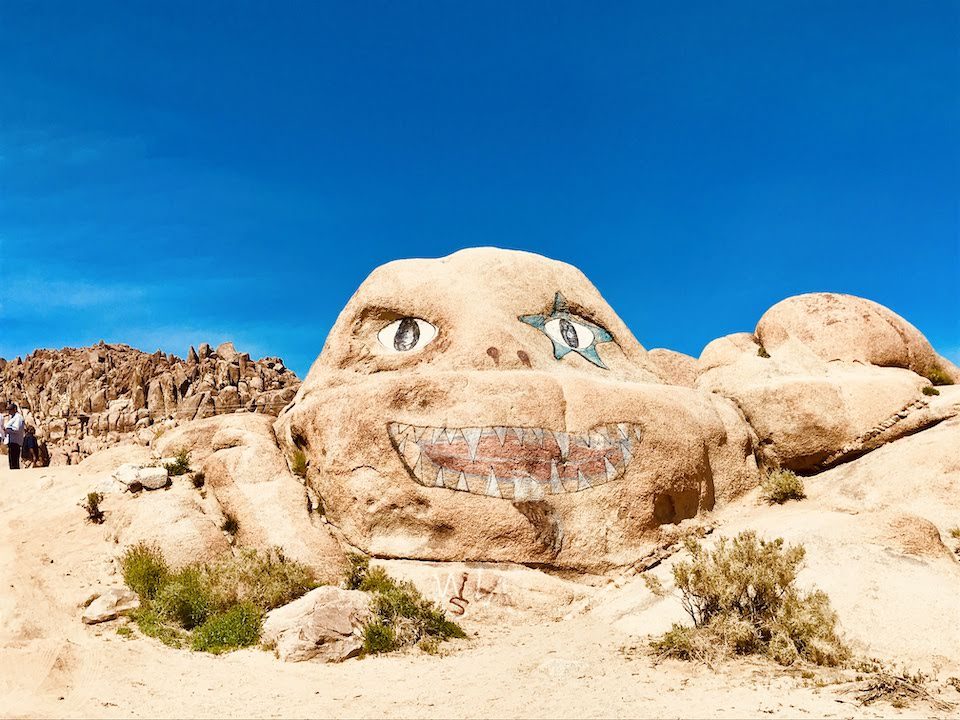
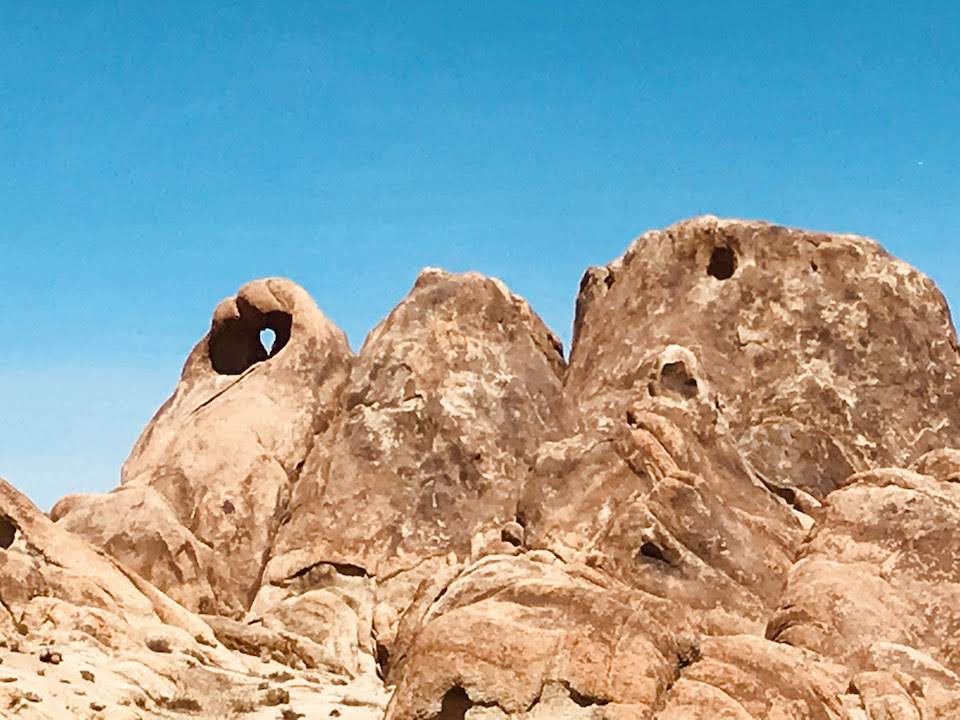
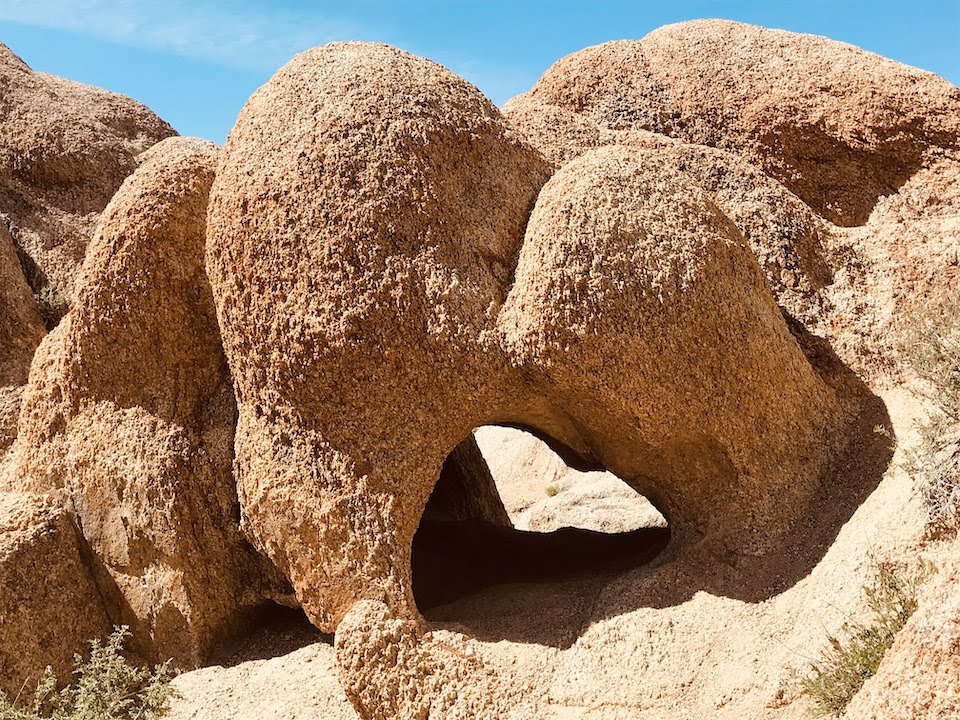
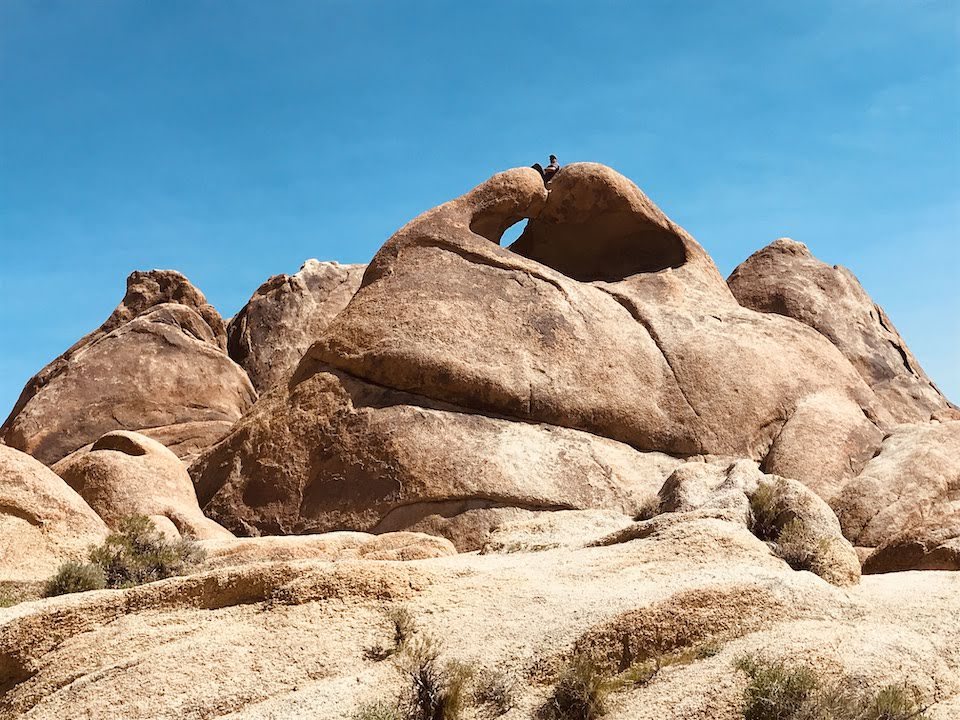
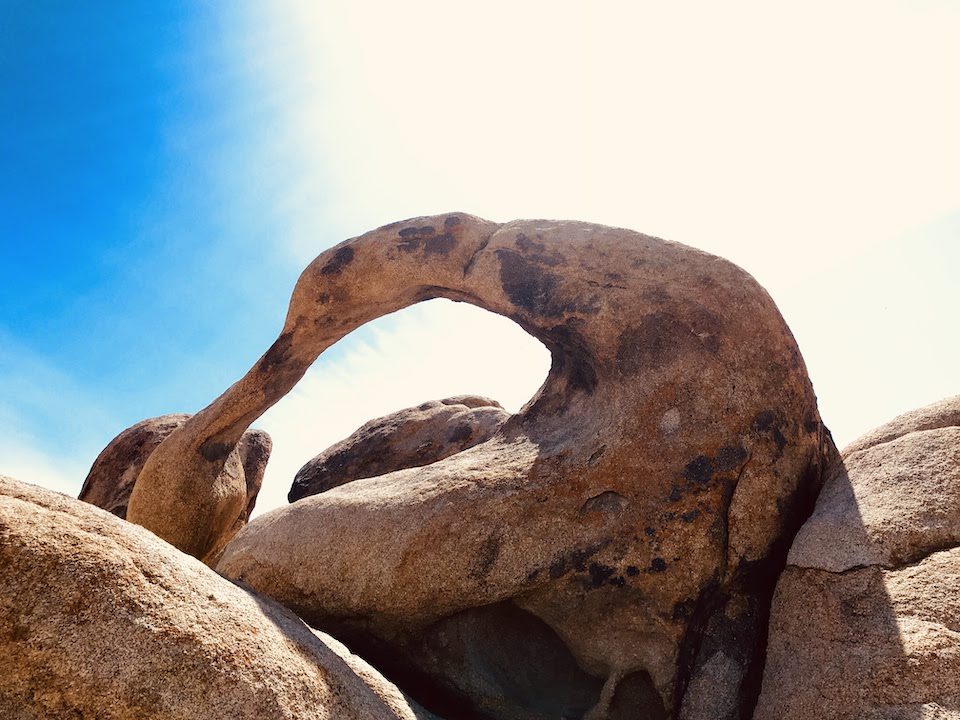
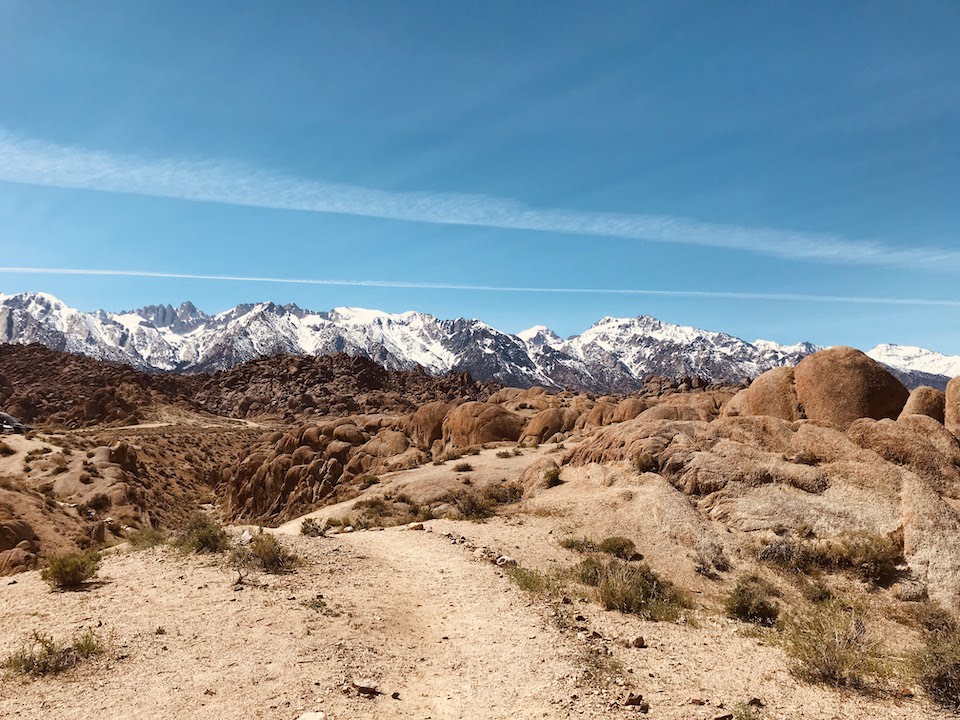
As we were leaving, I thought to myself that this is a place I would definitely like to return for a more relaxed visit. As a matter of fact, this entire itinerary deserves another look preferably in summer to cover all the places we missed due to winter closures. The majority of visitors to California frequent the other popular destinations and even road trips along the Big Sur over this hidden gem. But in my opinion, the Eastern Sierra Nevada has so much more to offer with an abundance of natural beauty and interesting places that I highly recommend you give this a try.

